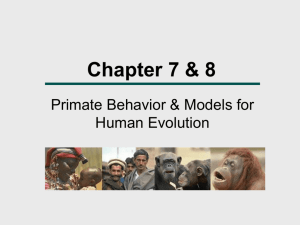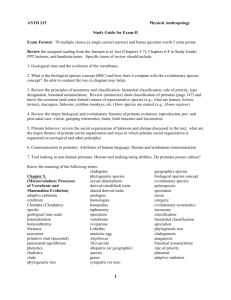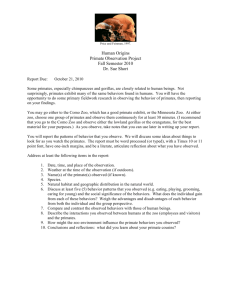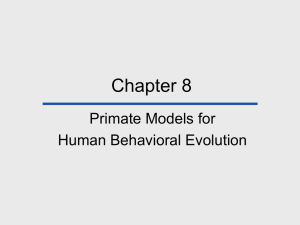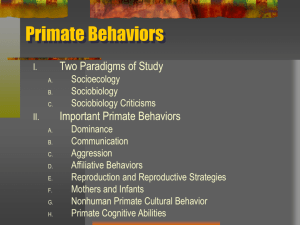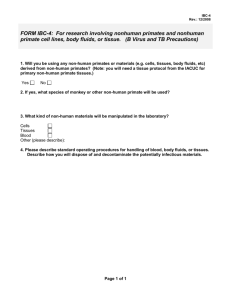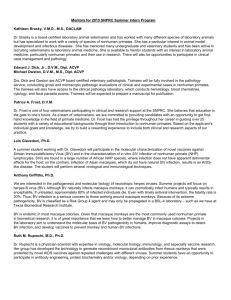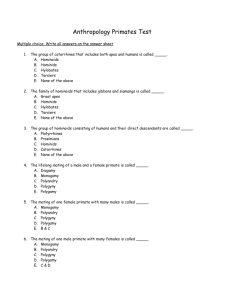Chapter 6 Primate Behavior
advertisement
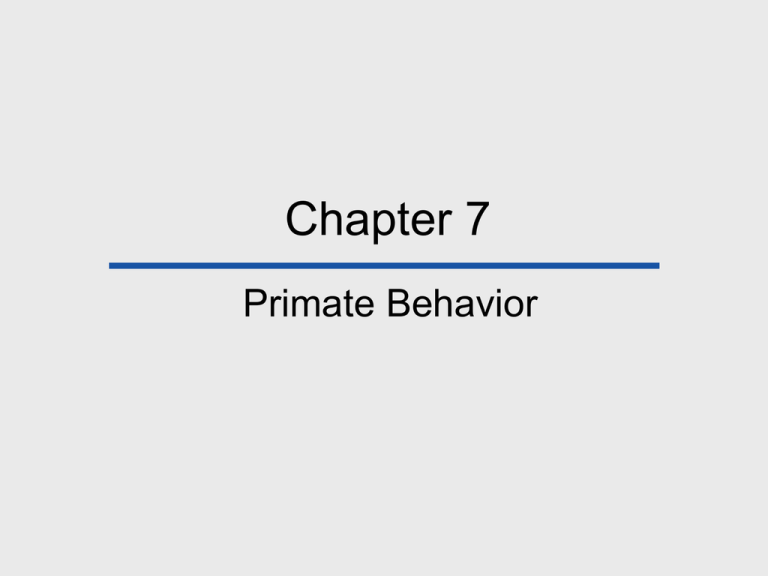
Chapter 7 Primate Behavior Chapter Outline • • • • • Primate Field Studies The Evolution of Behavior Sympatric Species Why Be Social? Primate Social Behavior Chapter Outline • • • Reproduction and Reproductive Behaviors Mothers, Fathers, and Infants Issue: Primates in Biomedical Research: Ethics and Concerns Behavior • • • Anything organisms do that involves action in response to internal or external stimuli. The response of an individual, group, or species to its environment. Such responses may or may not be deliberate and they aren’t necessarily the results of conscious decision making. Free-ranging • • Pertaining to non-captive animals living in their natural habitat. Ideally, the behavior of wild study groups would be free of human influence. Social Structure • • • • The composition, size, and sex ratio of a group of animals. Social structures are the results of natural selection in specific habitats, and they influence individual interactions and social relationships. In many species, social structure varies, depending on different environmental factors. Thus, in most primate species, social structure should be viewed as flexible, not fixed. Observing Primates • (a) Rhesus macaques spend much of their time on the ground and are easier to observe than (b) black-and-white colobus. Behavioral Ecology • • • An approach that focuses on the relationship between behaviors, the natural environment, and biological traits of the species. Based on the assumption that animals, plants, and microorganisms evolved together. Some behaviors are influenced by genes and are subject to natural selection the same way physical characteristics are. The Evolution of Behavior • • • Individuals with behavioral phenotypes that increase reproductive fitness pass on their genes at a faster rate than others. Behavior is a product of interactions between genetic and environmental factors. Species vary in their limits and potentials for learning and for behavioral flexibility. These limits and potentials are set by genetic factors favored throughout the evolutionary history of every species. Primate Social Structure • • • Social structures are the results of natural selection in specific habitats. They guide individual interactions and social relationships. Primates are among the most social of animals, so social behavior is one of the major topics in primate research. Factors That Influence Social Structure: Body Size • Larger animals are better able to retain heat and their overall energy requirements are less than for smaller animals. Factors That Influence Social Structure • Basal Metabolic Rate (BMR) and Diet Smaller animals generally have a higher BMR than larger ones. Consequently, smaller primates require an energy-rich diet high in protein, fats, and carbohydrates. Metabolism • The chemical processes within cells that break down nutrients and release energy for the body to use. Factors That Influence Social Structure • Distribution of Resources Leaves can be abundant and will support large groups of animals. Fruits and nuts occur in clumps. These can be efficiently exploited by smaller groups of animals. Some species that rely on foods distributed in small clumps tend to be protective of resources, especially if their feeding area is small enough to be defended. Distribution of Resources • This male mountain gorilla has only to reach out to find something to eat. Factors That Influence Social Structure • Predation Primates are vulnerable to many types of predators, including snakes,birds of prey, leopards, wild dogs, lions, and even other primates. Where predation pressure is high, large communities are advantageous. These may be multimale-multifemale groups or congregations of one-male groups. Factors That Influence Social Structure • Relationships with Other, Nonpredatory Species Many primate species associate with other primate and nonprimate species for various reasons, including predator avoidance. Factors That Influence Social Structure • Dispersal Members of one sex leave the group in which they were born when they become sexually mature. Individuals who leave find mates outside their natal group, so dispersal is believed to decrease the likelihood of close inbreeding. Factors That Influence Social Structure • Life Histories Life history traits are characteristics or developmental stages that typify members of a species and influence reproductive rates. Examples: length of gestation, length of time between pregnancies, period of infant dependency and age at weaning, age of sexual maturity, and life expectancy. Factors That Influence Social Structure • Distribution and Types of Sleeping Sites Gorillas are the only nonhuman primates that sleep on the ground. Primate sleeping sites can be in trees or on cliff faces, and their spacing can be related to social structure, predator avoidance, and how many sleeping sites are available. Factors That Influence Social Structure • Activity Patterns Nocturnal species tend to forage for food alone or in groups of two or three and many use concealment to avoid predators. Factors That Influence Social Structure • Human Activities Virtually all nonhuman primate populations are impacted by human hunting and forest clearing. These activities disrupt and isolate groups, reduce numbers, reduce resource availability, and eventually can cause extinction. Matrilines • • • Groupings of females who are all descendants of one female (e.g., a female, her daughters, granddaughters, and their offspring). Matrilines also include dependent male offspring. Among macaques, some matrilines are dominant to others, so that members of dominant matrilines have greater access to resources than do members of subordinate ones. Types of Nonhuman Primate Social Groups • One male-multifemale. Am adult male, several adult females, and offspring. The most common structure, typically formed by a male joining a kin group of females. Females usually form the permanent group. Examples: guenons, gorillas, some pottos, some spider monkeys, patas, some langurs, and some colobus. Types of Nonhuman Primate Social Groups • Multimale-multifemale Several adult males, several adult females, and their young. The presence of several males may lead to a dominance hierarchy. Examples: some lemurs, macaques, mangabeys, savanna baboons, vervets, squirrel monkeys, some spider monkeys, and chimpanzees. Types of Nonhuman Primate Social Groups • Monogamous pair The least common breeding structure among nonhuman primates. Extra-pair matings aren’t uncommon. Species that form pairs are usually arboreal, show minimal sexual dimorphism, and are frequently territorial. Examples: siamangs, gibbons, indris, titis, sakis, owl monkeys, and pottos. Types of Nonhuman Primate Social Groups • Polyandry One female and two males. This social group is seen only in some New World monkeys (marmosets and tamarins). Males participate in care of infants. Types of Nonhuman Primate Social Groups • Solitary Individual forages for food alone. This group is seen in some nocturnal prosimians (aye-ayes, lorises, and galagos). In some species, adult females may forage in pairs or may be accompanied by offspring. Also seen in orangutans. Philopatric • • • Remaining in one’s natal group or home range as an adult. In most species, members of one sex disperse from their natal group as young adults, and members of the philopatric sex remain. In most of the nonhuman primate species, the philopatric sex is female. Life History Traits • • Characteristics and developmental stages that influence rates of reproduction. Examples include longevity; age at sexual maturity; length of time between births, etc. Strategies • Behaviors or behavioral complexes that have been favored by natural selection to increase individual reproductive fitness. Sympatric • • Living in the same area. Pertaining to two or more species whose habitats partly or largely overlap. Primate Social Strategies Home Range • • The total area exploited by an animal or social group. Usually given for 1 year—or for the entire lifetime—of an animal. Predators • • When a baboon strays too far from its troop, it’s more likely to fall prey to predators. Leopards are the most serious nonhuman threat to terrestrial primates. Primate Social Behavior: Dominance • • • • Many primate societies are organized into dominance hierarchies. These impose order by establishing parameters of individual behavior. Higher-ranking animals have greater access to preferred food and mating partners than lower ranking individuals. Dominance hierarchies are sometimes called “pecking orders.” Breeding and Suppressed Males • Fully mature, breeding male orangutan with well-developed cheek pads (a) compared to a suppressed adult male without cheek pads (b). Factors that Influence Dominance Status Sex Age Aggression Time in the group Intelligence Motivation Mother’s social position Dominance • One young male savanna baboon mounts another as an expression of dominance. Primate Social Behavior: Communication • • • • • Raised body hair is an example of an autonomic response. Vocalizations and branch shaking are examples of deliberate communication. Reassurance is communicated through hugging or holding hands. The fear grin, seen in all primates, indicates fear and submission. Displays communicate emotional states. Threatening Behavior • • • An adolescent male savanna baboon threatens with a characteristic “yawn” that shows the canine teeth. Note that the eyes are closed briefly to expose light, cream colored eyelids. This has been termed the “eyelid flash.” Question • Dominance hierarchies a)guarantee that dominant males are more reproductively successful. b)result in dominant individuals having priority access to food. c)don't guarantee a reproductive advantage in dominant males. d)are permanent. Answer: b • Dominance hierarchies result in dominant individuals having priority access to food. Primate Social Behavior: Aggression • • • Conflict within a group frequently develops out of competition for resources, including mating partners and food items. Most intragroup aggression occurs in the form of various signals and displays within the context of a dominance hierarchy. Most tense situations are resolved through various submissive and appeasement behaviors. Primate Social Behavior: Aggression • • • Primate groups are associated with a home range where they remain permanently. Within the home range is a portion called the core area, which contains the highest concentration of predictable resources, and it’s where the group is most frequently found. The core area can also be said to be a group’s territory, and it’s the portion of the home range defended against intrusion. Displays • • Sequences of repetitious behaviors that serve to communicate emotional states. Nonhuman primate displays are most frequently associated with reproductive or agonistic behavior. Chimpanzee Facial Expressions Ritualized Behaviors • Behaviors removed from their original context and sometimes exaggerated to convey information. Primate Social Behavior Affiliative Behaviors • Common affiliative behaviors include reconciliation, consolation, and simple amicable interactions between friends and relatives. Hugging, kissing and grooming are all forms used in reconciliation. Relationships are crucial to nonhuman primates and the bonds between individuals can last a lifetime. Altruism, behaviors that benefit another while posing risk to oneself, are common in primate species. Grooming Primates • (a) Patas monkeys; female grooming male. (b) Longtail macaques. (c) Savanna baboons. (d) Chimpanzees Grooming • • Picking through fur to remove dirt, parasites, and other materials that may be present. Social grooming is common among primates and reinforces social relationships. Question • Affiliative behaviors a) arise when there is competition for resources. b) enhance group cohesiveness. c) are rare among primates. d) may include displays. Answer: b • Affiliative behaviors enhance group cohesiveness. Patterns of Reproduction • • • In most primate societies, sexual behavior is tied to the female’s reproductive cycle. Permanent bonding is not common among nonhuman primates. Male and female Bonobos may mate even when the female is not in estrus, a behavior that is not typical of chimpanzees. Estrous Swelling in a Female Chimpanzee Reproductive Strategies • • • Behavioral patterns that contribute to individual reproductive success. Primates produce only a few young in whom they invest a tremendous amount of parental care. (k –selected) Male competition for mates and mate choice in females are both examples of sexual selection. K-selected • • An adaptive strategy whereby individuals produce relatively few offspring, in whom they invest increased parental care. R-selected - An adaptive strategy that emphasizes large numbers of offspring and reduced parental care. K-selection and r-selection are relative (e.g., mice are r-selected compared to primates but K-selected compared to many fish species). Sexual Selection • • • • A type of natural selection that operates on one sex, usually males. Long-term, this increases the frequency of traits that lead to greater success in acquiring mates. Sexual selection in primates is most common in species in which mating is polygynous and male competition for females is prominent. Sexual selection produces dimorphism with regard to a number of traits, most noticeably body size. Infanticide As A Reproductive Strategy? • • • • One way males increase their chances of reproducing is by killing infants fathered by other males.’ Individuals maximize their reproductive success, no matter the effect on population or species. When an infant dies, its mother resumes cycling and becomes sexually receptive. An infanticidal male avoids waiting two to three years for the infants to be weaned before he can mate with their mothers. Mothers, Fathers and Infants • • • • The basic social unit among primates is the female and her infants. Except in species in which monogamy or polyandry occur, males do help rear offspring. Monkeys raised without a mother were not able to form lasting affectional ties. The mother-infant relationship is often maintained throughout life. Primate mothers with young. • (a) Sykes monkey. (b) Patas monkey. Primate mothers with young. • (c) Mongoose lemur. (d) Orangutan. (e) Chimpanzee. Infant Macaque Clinging to Cloth Mother Primate Cultural Behavior • • • Cultural behavior is passed from generation to generation through learning. Nonhuman primate infants, through observing their mothers and others, learn about food items, appropriate behaviors, and how to use and modify objects to achieve certain ends. Chimpanzee culture includes tools such as termite fishing sticks and leaf sponges.
